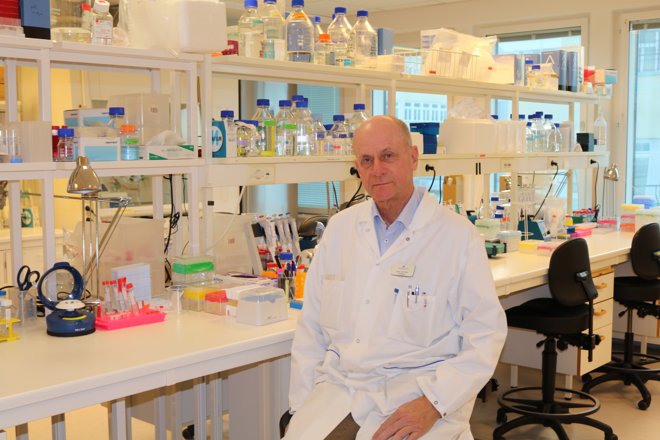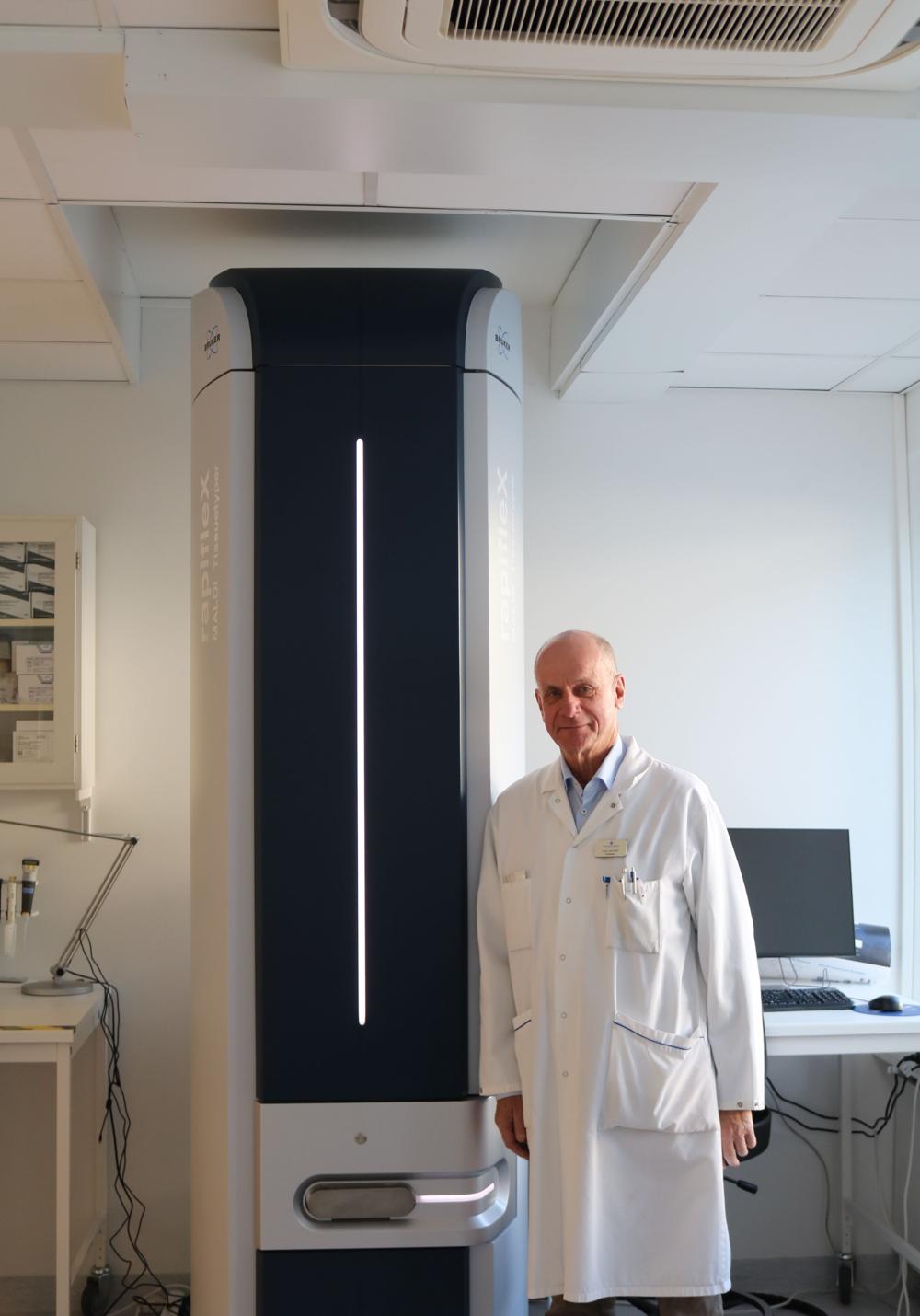Founder of Bioarctic, Lars Lannfelt, is honoured: “I want to create something for the future”
Lars Lannfelt kindly receives us at Bioarctic’s premises at Stadshagen in Stockholm. The head office and lab are housed on three (and soon four) floors in a property located not far from the site where Kabi Vitrum and several other major Swedish pharmaceutical companies used to operate.
“Sadly, there is not much left of the Swedish pharmaceutical industry today, and that has been a driving force for me and Pär (Gellerfors, co-founder of Bioarctic). We want to create something for the future, and we want Bioarctic to grow into something great that will remain after we are gone,” he says.
The chances of that dream coming true have increased recently. In July this year, the company’s drug lecanemab (Leqembi) was granted marketing authorisation by the US Food and Drug Administration (FDA).
It was thus the first fully approved drug to slow down Alzheimer’s disease - news that sparked enormous attention worldwide. Since then, an authorisation has also been granted in Japan, and a decision in the EU is expected before long.
However, the road to success has not been straightforward and it was paved with disappointments, as well as sweet revenge.
In the 1980s, Lars Lannfelt worked as a doctor and also researched the rare disease of acute intermittent porphyria. In 1991, he received a call from Bengt Winblad, Professor of Geriatrics at KI, suggesting a collaboration.
“Exciting developments had begun to take place in the field of Alzheimer’s, and genetics had begun to provide guidance. I accepted, and that was a good decision.”
The following year, Lars Lannfelt discovered a hereditary change linked to early Alzheimer’s disease. The finding seemed to confirm the importance of beta-amyloid in the development of Alzheimer’s, and American researchers dubbed it ‘the Swedish mutation’.
The discovery had a huge impact but also a bitter aftermath.
“I was working with a team in the US, and the patent ended up with one of them, which was terribly annoying. However, I was busy with my research and wasted no more energy on that.”
In 1998, he made yet another discovery, following a tip from a local doctor. In upper Norland, he found another mutation in a family with a strong history of Alzheimer’s. The mutation was later dubbed ‘the Arctic mutation’, and understanding the mechanisms behind it led to the idea behind lecanemab.
“My first thought was “I have to patent this”, as the desire for revenge was the biggest driving force for me at the time.”
In brief, the idea was that the treatment should target a particular form of beta-amyloid, small and soluble protofibrils, which are the most harmful.
He sent off a patent application and, at the same time, began working on the development of the antibody that would become the active ingredient in lecanemab, which took place in a lab at Uppsala University, where Lars Lannfelt had held a professorship since 2001.
Honoured with an award
Lars Lannfelt is awarded the 2023 Researcher of the Year Award for “pioneering efforts to understand and treat the underlying factors of Alzheimer’s, resulting in the world’s first disease-modifying treatment”.
To pursue the discovery’s commercial potential, he founded Bioarctic with his old colleague Pär Gellerfors in 2003. After some time, they started a collaboration with the Japanese company Eisai, which had the resources and expertise to handle the clinical development work.
“They have a great deal of experience in this kind of work and are really good at it, whereas we are strong at the molecular, preclinical side.”
The development of lecanemab progressed steadily, but at the same time, many scientists were sceptical - they didn’t believe in the strategy of attacking beta-amyloid. There was, and still is, a school of thought that favours targeting the protein tau, which is also linked to brain changes in Alzheimer’s.
Academic humour has commonly dubbed the two groups ‘Baptists’ and ‘Tauists’.
“Having different opinions is a healthy thing, but I’m pretty sure we’re right, and I think the success of lecanemab proves it,” says Lannfelt.
Although the drug has now received its first approvals, there are still objections, including what benefits it will have for patients.
Clinical trials have shown that Lecanemab slows the progression of early Alzheimer’s by 27%, which some would claim is a modest effect. What do you say to them?
“That these are studies of 18 months, while the disease may have been in progress for 15 to 20 years before that. I think that in the long term, a lower maintenance dose will be used and that the treatment period will be very long, perhaps for life.”
The treatment is resource-intensive, with hospital infusions every two weeks and also MRI scans to detect possible side effects. Will this be a widespread treatment for large groups?
“I find it very difficult to estimate that. It will probably take a while to get started because the healthcare system is not really prepared today. I hope that a subcutaneous formulation will be developed in the future so that patients can use it at home, either by themselves or with the help of a district nurse. That would make it easier.”
“I think a major advance will come when we develop technologies that increase the ability of antibodies to enter the brain more efficiently. That will make treatment more effective and much cheaper.”
Bioarctic is currently working on such a project that aims to develop a method to improve the transport of biological drugs across the blood-brain barrier. The company also has development projects in Parkinson’s and ALS.
Bioartic’s stock has soared with the success of lecanemab, and by the end of October, the market value was over SEK 21 billion. Lars Lannfelt still owns one-third of the shares, and basic maths tells us that he has no financial reason to lift another finger in his life. Yet, at the age of 74, he still gets up every morning and goes to work in Kungsholmen in Stockholm.
You can now reap the benefits of over 30 years of work. Can’t you just sit back and enjoy it?
“Well, I am happy and content, of course, but I still work full-time because I enjoy it and want to keep track of what’s happening. At the same time, I trust my colleagues, and it’s important for me to be able to cope. I work with a fantastic bunch of people.”
LARS LANNFELT
Age: 74
Family: His wife, Lotta Silfverhielm, is an artist and author of children’s books, two children and two grandchildren.
Lives: In an apartment in Södermalm in Southern Stockholm. “I grew up in Enskede, and then Södermalm is where you end up when you leave your parent’s home.”
Job/career: PhD at the Karolinska Institute in 1990, Professor of Molecular Geriatrics at Uppsala University since 2001, elected to the Royal Swedish Academy of Sciences in 2004, co-founder of the company Bioarctic, which develops treatments for Alzheimer’s, Parkinson’s and ALS.
Hobbies: “When Lotta and I met, we each had a yacht, so sailing and the Stockholm archipelago are two of our favourite pastimes. Now I have a motorboat, and we have a house on Runmarö where we spend a lot of time.”
How he and his wife plan to spend the money from lecanemab: “We’ve started working on a foundation, but it’s still early days. It’s quite complicated, but our idea is that the foundation will provide grants for research and culture.”
Latest book read: Ingrid Carlberg’s “Marionetterna” (The Marionettes) - a story about the world as a political theatre, and Kjell Westö’s “Skymning 41” (Twilight 41).
Artikeln är en del av vårt tema om News in English.

 Av
Av 